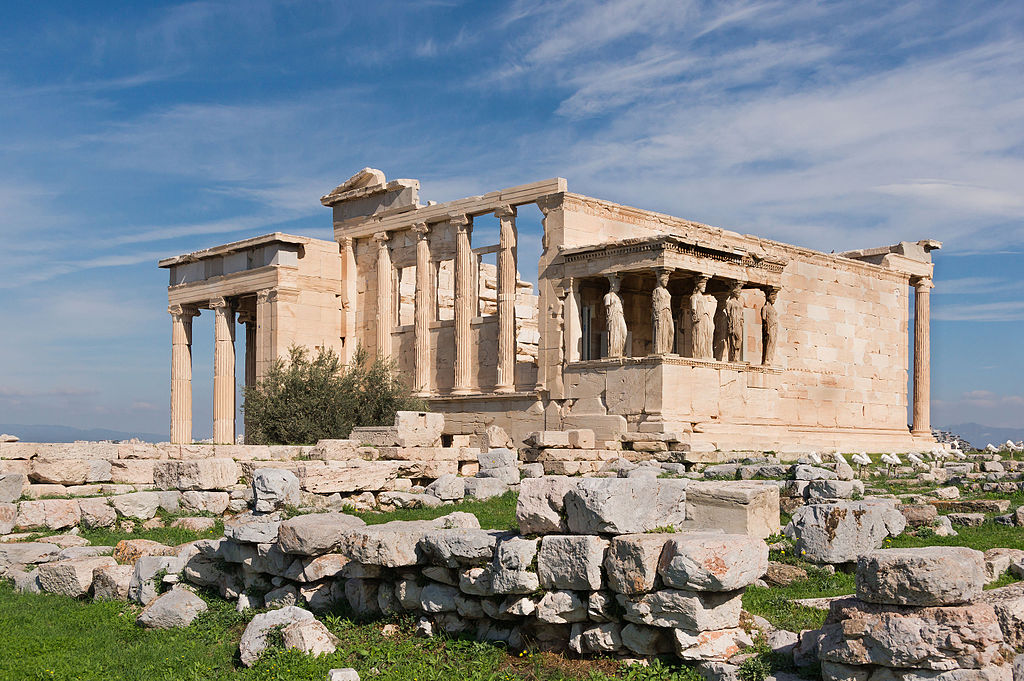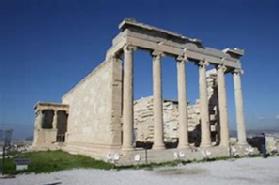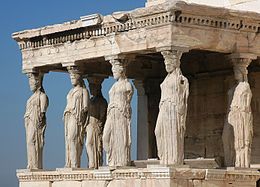The Erechtheum, Acropolis at Athens
To find your page, see the list under Handouts and click the correct tab on the Archaeological site database.
Please edit the page properties (see here for instructions) to change the title to the name of the archaeological site you will be writing about, then replace the Italicised instructions below with your entry... If you want to know how to add e.g. additional images, podcasts, etc., please see this page. If copying from word, rather than using CTRL-V, please click the small "paste from word" icon (with a 'w') which neatens up the formatting.
Archaeological Development
The Erechtheum, named after the great Athenian leader Erechtheus, begun its construction before the outbreak of the Peloponnesian War in 431 BC, though since then it underwent breakings and damages and it was finally finished in 409/8 BC. This temple was rebuilt on the remains of an older temple, fittingly names the 'Old Temple' though this initial structure faced damage by the Persian wars. It had been rebuilt various times but it had caught fire. It's renewal would turn it into the Erechtheum which stands till this day.
The Erechtheum was the last building on the Acropolis to be built under the instruction of Pericles, its architect was Mnesicles. This incredibly irregular and complex temple housed the ancient cult statue of Athena Polias who would be adorned with the peplos at the Panathenaea festival (see below). The building encompassed sites which had been dedicated to a variety of heroes and gods and its asymmetry and multiple ground flooring is due to the geographical nature of the site which slopes. This has also caused the building to have perpendicular porches and unroofed precincts.
Perian marble makes up most of its material matter, though limestone was used to create the friezes running on the outside and inside porches of the temple. The Erechtheum also features the Ionic style, which is thinner and easily identifiable by the volute scrolls at the top, mostly which contrasts the more severe Doric style of the Parthenon. Vitruvius (4.8.4) described the temple as 'having all the features which are customarily on the front transferred to the flanks'. There are six columns in prostyle arrangement at the east, an immense ionic porch projects from the west end of the long north wall and the Maiden Porch (also known as the Caryatids) highlights the south wall. The interior plan has been obscured by the aforementioned re-buildings. The west end of the Erechtheum faced the most major adjustments as it had to be constructed ensuring the temple did not encroach on some of the sacred spots such as the sacred Olive tree (gifted to the Athenians by their patron goddess Athena) and the tomb of Kekrops which the Maiden Porch signals. The Caryatids porch is actually one of the most unique features of the Erechtheum as it uses sculptures of maidens to represent the columns. They are all in contrapposto placing all their weight on one leg while the other is relaxed and protrudes slightly. The creases in their peplos imitates the fluting found on columns. The positions of the maidens show that the task of holding the roof of the porch is effortless for them. Their expressions remain detached and emotionless which is typical of the sculptures of the classical period.
Gods/Heroes
Unlike the neighbouring Parthenon, the Erechtheum is dedicated to a multiplicity of gods and heroes. Firstly it celebrates the gods Athena and Poseidon for they went to war with each other battling for the right of patronage of Athens. Athena won this war by giving the Athenians an olive tree which is still present today on the Erechtheum grounds. Aside from these prominent figures the great Athenian rulers Erechtheus himself and Kekrops share a tomb in the Erechtheum. Moreover there is an altar dedicated to the tribal hero Boutes and a shrine to Pandion.
Ritual Activity
Sacrifice-
add text here as appropriate. Note that "shift + enter" inserts a line break without any paragraph spacing.
Dedications-
add text here as appropriate
Festivals-
add text here as appropriate
Other-
add text here as appropriate
Rules and Regulations
note here any rules and regulations relating to sanctuary use that have been found inscribed in and around the site.
Other Activities
specify activities, known dates, and ancient sources.
Historical Significance
Replace this with a discussion of the historical significance of the site
Who used the site, and where did they come from?
Replace this with a discussion of the different communities who used the site, including dates and sources.
Select Site Bibliography
Insert a bibliography here.
Images:
Top: Jebulon [CC0] https://commons.wikimedia.org/wiki/File:Erechtheum_Acropolis_Athens.jpg
Middle left: Babbage [CC BY-SA (https://creativecommons.org/licenses/by-sa/4.0)] https://commons.wikimedia.org/wiki/File:Erechtheion-floor-plan.svg
Middle right: Giovanni Dall'Orto. [Attribution] https://commons.wikimedia.org/wiki/File:2675_-_Athens_-_Erechtheum_-_Southern_flank_-_Photo_by_Giovanni_Dall%27Orto,_Nov_11_2009.jpg
Bottom: Harrieta171 assumed (based on copyright claims). [CC BY-SA (http://creativecommons.org/licenses/by-sa/3.0/)] https://commons.wikimedia.org/wiki/File:Ath%C3%A8nes_Acropole_Caryatides.JPG
Footnotes
1- To enter footnotes, put [1] in your text above, and place the footnote down here.
2- If you press "shift + enter" it will insert a line break without any paragraph spacing.
Location
Please add the location here. Also, search for it on Pelagios (click here) and add a link to "further information" about the place.
You might even want to embed a map to show it within the context of other archaeological sites from vici.org, like below. To find out how to do this, see the further instructions page.




